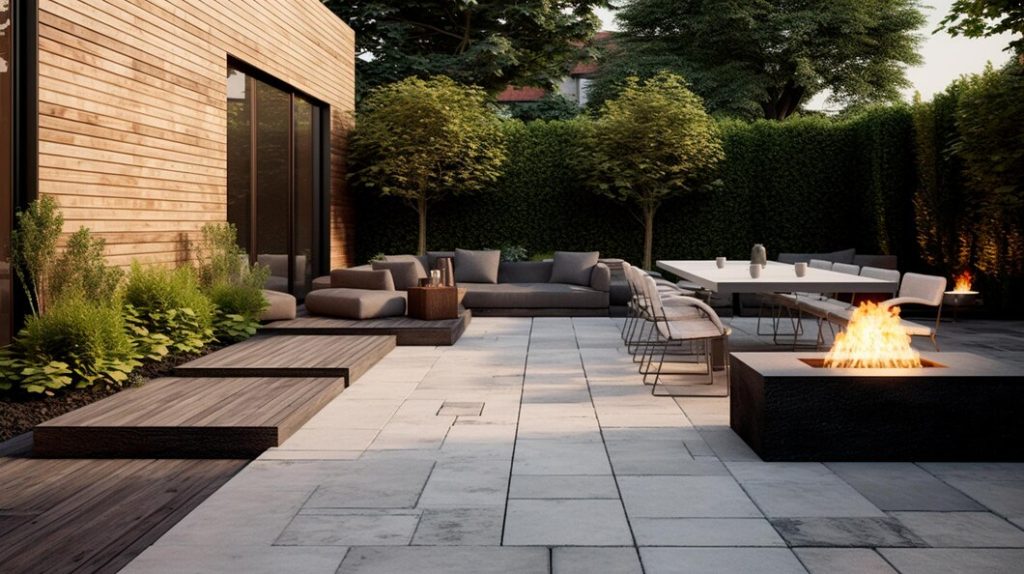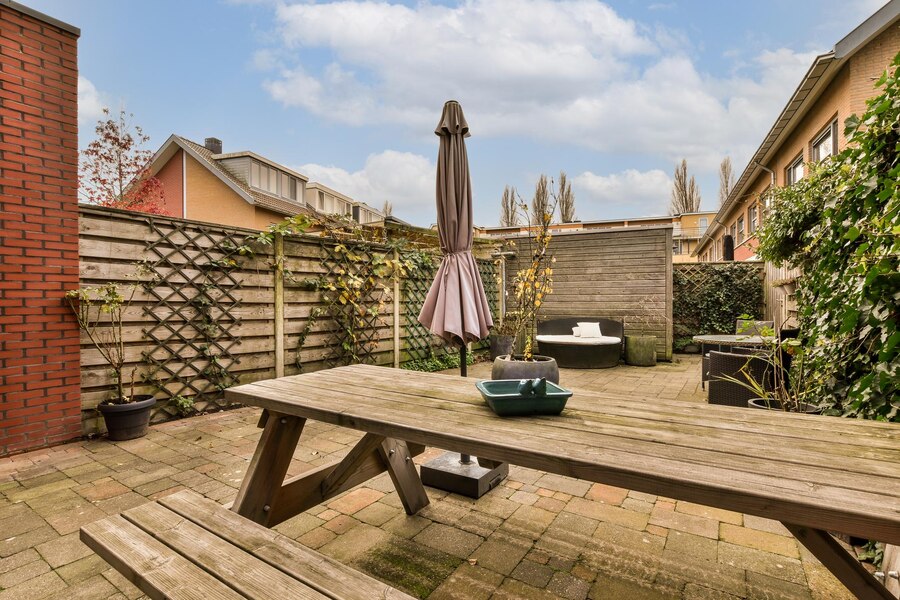The Top 8 Cheapest Patio Flooring Options (Pros & Cons)
14 Jun, 2024
Table of content
- Factors To Consider Before Choosing Patio Flooring
- The Top 8 Cheapest Patio Flooring Ideas
- 1. Concrete Pavers
- 2. Gravel
- 3. Rubber
- 4. Natural Stone
- 5. Mulch
- 6. Composite Deck Tiles
- 7. Brick
- 8. Grass
- Maintenance Tips for Affordable Patio Flooring
- Are DIY Installations Feasible for Budget-Friendly Patio Flooring?
- Summing Up
Patios are a great way to add extra living space to your home without breaking the bank. You can get away with flooring and some outdoor furniture to create a cozy dining and relaxation area in your backyard.
Flooring is the key element of the patio, so if you aren’t going to spend much on your patio, consider using cost-effective flooring materials. But what is the most cost-effective patio flooring? Well, you have several options to choose from. Read on to explore the most inexpensive patio floor ideas, with their pros and cons included.

Factors To Consider Before Choosing Patio Flooring
The choice of patio flooring should primarily depend on your specific needs and the local climate. Let’s look at the key factors to consider before selecting outdoor flooring:
- Climate. Some materials may better suit hot and dry climates, while others perform well in wet or cold conditions.
- Durability. Assess the amount of foot traffic and potential impact your patio is supposed to receive, and select a material that can withstand these factors without excessive wear.
- Maintenance. Consider the level of maintenance you are ready to carry out. Some materials, like natural stone or wood, may require regular sealing, staining, or cleaning, while others, like concrete or composite decking, may need less maintenance.
- Aesthetics. What design and aesthetics do you want for your patio? Different materials offer various colors, patterns, and textures and allow you to create a patio that perfectly complements your home’s architecture and pathway.
- Comfort. Consider the comfort of the flooring underfoot. Some materials may retain heat in the sun, making them uncomfortable in hot weather.
- Slip resistance. Choose a slip-resistant surface if your patio is frequently exposed to rain or other sources of moisture.
- Installation complexity. Assess the complexity of installation and decide whether you plan to install the flooring on your own or hire a professional. Some materials may require specialized skills or tools.
- Intended use. Think about how you plan to use the patio. If it’s primarily for dining, prioritize a material that can provide an even surface.
- Building codes. Finally, check local building codes or regulations that may dictate the type of flooring allowed for porch construction.
The Top 8 Cheapest Patio Flooring Ideas
Here’s the list of the cheapest patio flooring ideas with pros and cons to help you choose the best surface for your outdoor space.
1. Concrete Pavers
There’s little wonder that the most popular choice for outdoor space flooring is concrete. Besides being one of the cheapest patio flooring options, concrete is easy to maintain and can last for years. Concrete pavers come in various sizes, shapes, colors, and textures, allowing for multiple design options.
Pros
- Durability
- Versatility
- Easy installation
- Low maintenance
- Slip resistance
- Natural drainage
- Quick use after installation
Cons
- Weed growth requires occasional maintenance
- Prone to cracking
- Requires a base
- Can become uneven over time
2. Gravel
Pea gravel is another budget-friendly option for outdoor flooring. Smooth pea-sized stones create a comfortable and natural surface, delivering a charming rustic vibe. Gravel flooring is probably the easiest to install — it doesn’t even require a base. However, be ready to periodically refill your gravel flooring since gravel tends to get displaced.
Pros
- Natural look
- Excellent drainage
- Comfortable to walk on
- Easy installation
- Environmentally friendly
Cons
- Limited load-bearing capacity
- Displacement over time
- Difficult to move furniture
- Not suitable for high-activity areas
- Can be too unstable for some furniture
- Can stick to shoes

3. Rubber
Rubber is becoming increasingly popular as an alternative to conventional flooring materials for outdoor spaces. One of the cheapest patio flooring options, rubber flooring provides a comfortable and slip-resistant surface. In addition, it’s low-maintenance, durable, and available in various colors, enabling homeowners to create a truly unique look.
Pros
- Cushioned surface
- Slip resistance
- Low maintenance
- Weather resistance
- Shock absorption
- Stain resistance
Cons
- Prone to discoloration when exposed to UV rays
- Initial rubber smell
- Can be easily damaged by sharp objects
- Can retain heat
- Can harden in extreme temperatures
4. Natural Stone
Natural stone is an elegant choice for patio flooring, known for its durability. Natural stones boast unique textures and earthy tones, perfectly addressing even the most demanding landscaping needs. Natural stone calls for a flat base, such as sand or concrete, for proper installation. Still, it’s long-lasting and relatively low maintenance, making it one of the cheapest patio flooring options.
Pros
- Natural look
- Durability
- Varied textures
- Low maintenance
- Environmentally friendly
- Suitable for all climates
Cons
- Potential for uneven surface
- May absorb heat
- Regular sealing required
5. Mulch
Mulch flooring is made from engineered wood fiber, which makes it an environmentally friendly and cost-effective choice for a patio. However, mulch is a loose-fill material, meaning it’s prone to displacement. Because of this, you’ll need to regularly rake and refill your patio.
Pros
- Natural look
- Easy to install
- Biodegradable and eco-friendly
- Soft and comfortable underfoot
Cons
- Requires periodic refills
- Attracts pests
- Limited load-bearing capacity
- Challenging to move furniture
- Not suitable for high-traffic areas

6. Composite Deck Tiles
Composite deck tiles are a modern and convenient option for patio flooring. They’re durable, water-resistant, and easy to clean. Composite tiles can look like natural wood, making them a stylish choice for your patio.
Pros
- Easy installation
- Versatile design options
- Low maintenance
- Durable
- Interlocking system for stability
- Resistant to moisture
Cons
- May fade over time
- Can heat in direct sunlight
- Not suitable for uneven ground
7. Brick
Brick is a classic choice for patio flooring, loved for its traditional look and robust characteristics. Brick pavers boast outstanding strength and durability — the material can withstand extreme temperatures and is immune to rot and pests. In addition, it’s a long-lasting solution — even if individual pavers are damaged, you can replace them to maintain the visual appeal of your patio.
Pros
- Durable and long-lasting
- Low maintenance
- Environmentally friendly
- Excellent load-bearing capacity
- Resistant to fading
- Cool surface in hot weather
Cons
- Prone to moss or mildew growth
- Limited DIY options
- May shift over time
- Potential for uneven surface
- Susceptible to cracking
8. Grass
You can use both natural and artificial grass as patio flooring to create a soft and green surface. While real grass needs regular care, artificial grass, also known as synthetic turf, requires minimal maintenance, providing a consistent appearance throughout the year.
Pros of natural grass
- Soft and comfortable underfoot
- Cooling effect
- Environmentally friendly
Cons of natural grass
- Requires regular maintenance
- Seasonal changes in appearance
- Potential for pests and weeds
- Limited durability
- Susceptible to disease and drought
Pros of artificial grass
- Consistent green appearance
- Low maintenance
- Durable and resistant to wear
- Suitable for various climates
- Quick installation
Cons of artificial grass
- May retain heat in direct sunlight
- Limited environmental benefits
- Non-biodegradable
- Requires proper drainage
- Relatively short lifespan (10-20 years)
So, what is the cheapest patio flooring? There’s no absolute answer. While some materials may be inexpensive, they may also have a shorter lifespan or be easily damaged by the elements, mold, or pests. On the other hand, some more expensive options can serve you for decades without special care.
Maintenance Tips for Affordable Patio Flooring
Maintaining your patio flooring is essential to ensure its longevity and functionality. While different types of patio flooring require different maintenance approaches, here are some general maintenance tips to help you keep your patio flooring at its best:
- Regularly clean your patio surface from debris and dirt.
- Inspect and remove any weeds growing in the gaps between pavers.
- If your patio has porous materials like natural stone or concrete, consider applying a sealer to protect against stains and moisture penetration.
- Immediately clean spills, especially those from oils, food, or beverages, to prevent stains.
- Use coasters under planters to avoid water stains on the patio surface.
- Ensure the patio has proper drainage to prevent water pooling, which often leads to mold, mildew, and damage to certain materials.
- Use mild cleaning solutions and avoid harsh chemicals that may damage or discolor the flooring.
- Test any new cleaning product in a small, unnoticeable area before widespread use.
- If your patio has joints filled with sand or other materials, check and reapply as needed to maintain stability and prevent weed growth.
- If your patio receives a substantial amount of direct sunlight, consider using UV-resistant materials or applying a UV protectant to prevent fading.
- Protect the patio from snow and ice if you live in a region with harsh winters.
Are DIY Installations Feasible for Budget-Friendly Patio Flooring?
Most cheap patio materials are designed with easy installation in mind, making them accessible for homeowners who want to save on labor costs. So, let’s see in a nutshell how to make inexpensive patio flooring.
The top DIY-friendly patio flooring options are the loose-fill gravel and mulch — you only need to spread the material evenly over a prepared surface. Installation of artificial grass, which usually comes in rolls or tiles, involves preparing the base, cutting the material to fit, and securing it in place.
Concrete and brick pavers, natural stone, rubber sheets, and interlocking deck tiles should be placed on a leveled and compacted surface, and, depending on your skills, you may install them without professional assistance.
Summing Up
Today’s wide choice of patio flooring options catering to diverse styles and needs allows homeowners to choose the material that meets any budget. Moreover, most cheap outdoor patio flooring ideas involve easy installation, making them even more cost-effective.
